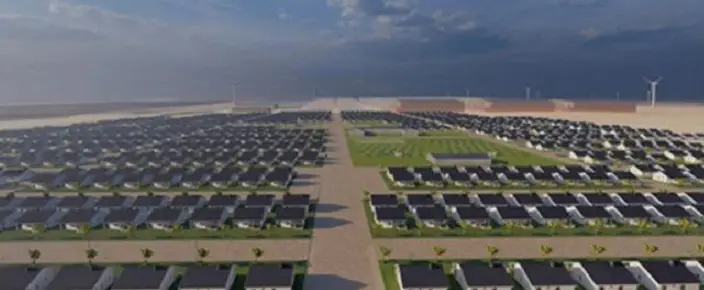According to reports, Daures Green Hydrogen Village will be Africa’s first net-zero village after Fortescue Future Industries, and Enersense Energy Namibia, two companies that specialize in the production of renewable energy, signed a memorandum of understanding (MoU) to work together to accelerate the growth of Namibia’s green hydrogen market.
The MoU aims to power the village by co-producing green hydrogen and green ammonia.
Read also: BP to study the potential for green hydrogen production facility in Egypt
To guarantee the success of the Namibia project, Enersense Energy Namibia will leverage Fortescue Future Industries’ extensive global expertise in the development of green hydrogen.
The Daures Green Hydrogen Village, which will be constructed through 2032, will serve as a demonstration of the concept for large-scale green hydrogen production, exploitation, and exportation to international and regional markets in Namibia. It will include large-scale solar, wind, hydrogen, and ammonia production systems as well as transportation networks.
According to the terms of the Memorandum of Understanding, Fortescue Future Industries and Enersense Energy Namibia will collaborate to conduct a feasibility study on the effectiveness of using green ammonia and green hydrogen generated from the project to power electricity production and farming, including the production of fertilizer.
The project comes just after the Daures Green Hydrogen Village project secured financing from the German Federal Ministry of Research and Education for the installation of a 500 kW electrolyzer and a 1 MW renewable energy generator as part of the project’s first phase.
The CEO of Daures Green Hydrogen Village, Jerome Namaseb, said that the village’s phase one plan has the possibility of providing over 50 ongoing sustainable jobs, 100 short-term jobs during construction, and will achieve production of Namibia’s first batch of green hydrogen, green ammonia, and carbon-free agriculture. The village plans to be the first net-zero community in Africa and has the capacity to produce over 1 GW of renewable energy and approximately 350,000 metric tons of ammonia.
Additionally, the project is expected to provide energy for agricultural projects being carried out by the University of Namibia and the University of Stuttgart.
Daures Green Hydrogen Village in Namibia inaugurated
Phase 1 of the development will see the Village produce 31 tons of hydrogen and 109 tons of ammonia annually while using 0.99 MW of renewable energy. 500 tons of tomatoes and 600 tons of carrots will therefore be produced during phase 1 as well.
According to the consortium, this will be Namibia’s first producer of carbon-free agriculture. In phase 1, the project will create over 70 long-term jobs and over 100 temporary jobs. As per the consortium, the Village will produce Namibia’s first batch of green hydrogen and green ammonia. It will be used for domestic consumption on the project site.
What will be used to power the Daures Green Hydrogen Village
The facility will be powered by fuel cells and project research using green hydrogen and ammonia. The consortium states that phase 1 will begin with an official groundbreaking ceremony in March 2023.
It added that the project’s fourth phase will produce 352,000 tons of green ammonia. It will use a 420 MW electrolyzer and 1 GW of renewable energy. Phase 4 will also generate over 1,000 green, sustainable jobs.
DGHV Chief Executive, Jerome Namaseb, stated at the launch that these agreements offer a significant opportunity for continued collaboration between the hydrogen industry and other existing industries in the project area.
The consortium signed MOUs for corporate social responsibility programs, the offtake of up to 40,000 tons of green ammonia, and, sequentially, the provision of water in the area for later phases.
The Rossing Foundation, Sable Chemical Industries Limited, and Afritin Mining, which runs the Uis Tin Mine, are among the entities that have signed the MOUs.
The project’s aim
The Village is dedicated to reducing reliance on carbon-based fuels. It will offer long-term green employment to the people of the Daures Constituency and of Namibia as a whole.
The memorandum of understanding with the Rossing Foundation also calls for collaboration between the parties on CSR initiatives.
The Village, according to Namaseb, will be the first net zero village in Africa.
The Daures Green Hydrogen Village will show the production of green hydrogen.
In terms of project phasing, phase 1 of the pilot is set to begin in 2022–2023 and phase 2 in 2023–2024. Phase 3 is also scheduled for 2026–2028. Also, phase 4 is slated for 2029–2032.

